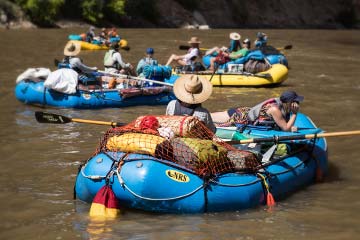Yoga for Off-Season Paddling Fitness
If you live in a cold place and can’t travel anywhere warmer this winter, try adding some yoga to your off season paddling routine. There are a number of benefits that a weekly yoga routine can do for you. First, yoga is about moving with awareness, so you get a mind-body connection that will be beneficial to your paddling. Also, moving with more awareness can improve your body’s function and help you heal up some old injuries. Second, yoga improves your breathing, so when you hit the water again in the spring, you won’t feel as winded. Third, the yoga exercises are not isolated to one area of the body: they both strengthen and stretch the muscles of the whole body.
I picked out 12 yoga poses that you can add to your exercise routine this winter. You can add them into a weight training routine, a cardio routine, do them as a stand-alone workout, add them to another yoga routine—basically however you want. Be creative!
(If you do these as a stand-alone yoga workout, be sure and end the session lying down in Corpse Pose at the end. To do a corpse pose, simply lie on the floor in a comfortable position and let go of all muscular activity. It allows your body to recover from the exercises.)
As you do yoga, be sure and breathe fully. Also, move slowly, paying attention to your body’s cues. Do not push through pain or resistance. Instead, move in a way that feels good to your body. Your range of motion will increase better if you’re kind and gentle to your body.
Yoga is best done by finding a balance between effort and ease. Listen to your body and find this place for you in each pose. This place can change from day to day as well. You know you are over-efforting if you have tension in your jaws or you’re squinting your eyes. If you have too much ease, your mind will wander and your poses will feel weak. Find that place where you feel engaged in the pose, yet free from tension—it’s like having a dance with yourself!
The off-season can be great for your body and your paddling. Take advantage of this time when your body isn’t being worn down by continuous days on the water to work your body in different ways and strengthen your weak spots. You will find a better connection to yourself and emerge fresh and ready to roll in the spring!
Boat Pose
This pose mainly strengthens your hip flexors (your boofing muscles), but it also requires your transverse abdominus (the main player for core strength) for balance.
Begin sitting with your legs bent in front of you and your feet flat on the floor. Lift in and up with the inner thighs, pelvic floor and navel. Lift up through the spine and the crown of the head. Broaden the collarbones and draw the shoulder blades down the back.
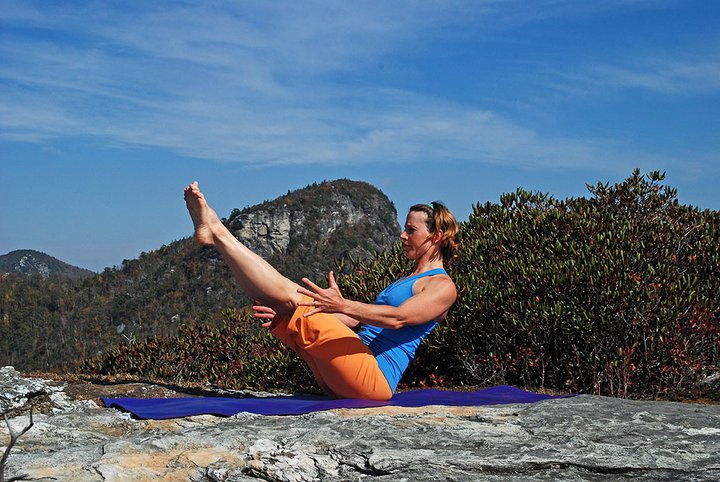
Using your hands on the floor next to your hips for balance, exhale and lift your feet off the floor. If you need more challenge, lift your hands and straighten your arms in front of you. Lift up with the back body as much as with the front body. Keep your collarbones broad, relax your face and jaws, and breathe evenly.
To take it all the way, straighten your legs. (Only do this if your legs and hips are flexible enough! To know, ask yourself if you can bend forward this far in a seated forward bend or a standing forward bend).
Plank Pose
This is the classic core exercise. If your shoulders hurt or pinch, try doing the shoulder exercise from my article Yoga for Boaters’ Shoulder Pain. If you want to spice it up or the pose hurts your wrists, you can do the plank pose on your forearms.
Start on your hands and knees (Tabletop). Lift your knees off the ground and straighten your legs behind you so that your body looks like a plank. Push back through your heels. Push up with your abs particularly at the bottom of your rib cage. Make sure you breathe.
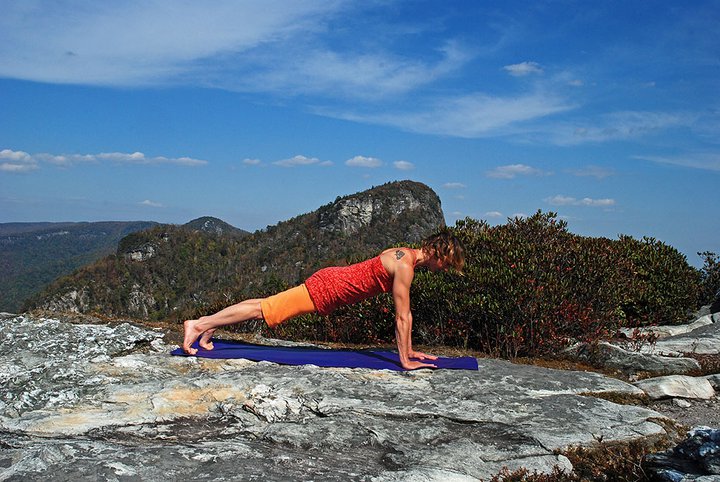
If this pose hurts your wrists, it often means they are not flexible enough to put weight on them in that position. You can hang out in Tabletop to work on wrist flexibility. It can also mean that you have shoulder issues, so I recommend working on shoulder function. It can also mean that you have weak core strength. If so, you can do the pose with your knees down and work your way up.
Side Plank
From Plank Pose, lift your left arm off the ground as you rotate your body to face to the left, stack your left leg onto the top of your right leg, and then reach your left arm up. Do not move through pain in your shoulder! This pose is great for the muscles and stability of your shoulder if your body is ready for it. Envision you are rotating around your right shoulder. While you are in the pose, lift up from your right armpit and your right side waist. Don’t let the body sag—feel strong and supported.
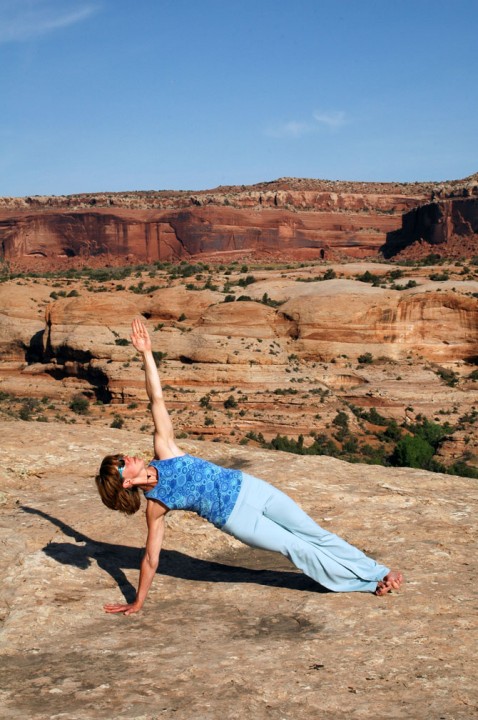
Down Dog
From Tabletop position, push into your hands, and use your core muscles (by envisioning that you’re are lifting up from your belly button) to lift your butt up and press your heels towards the floor.
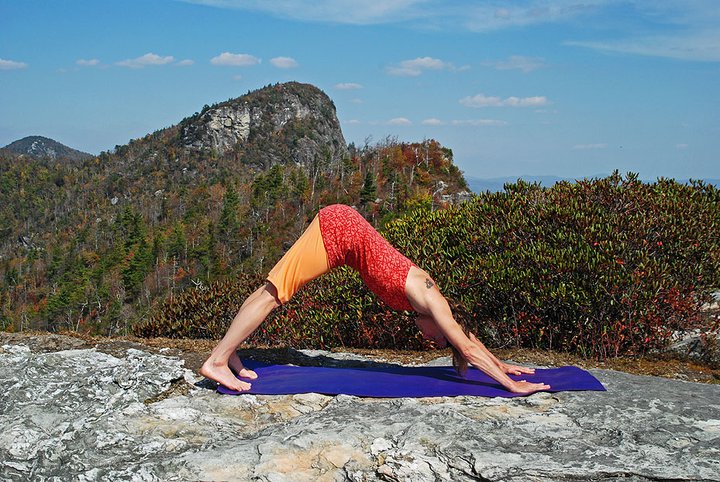
To spice up the previous three poses connect them: go from Plank—Down Dog—Plank—Side Plank; or Down Dog—Plank—Side Plank—Down Dog. You can also do the whole sequence on your forearms to work the muscles differently.
Warrior 2
From standing, spread your feet a few feet apart. You can play around with the width of the stance to suit your body. Turn your right leg out 90 degrees and your left leg in slightly. Bend your right knee. Make sure that your right knee stays aligned over your right heel and isn’t falling inward or outward. Again make sure that your hips don’t tilt or rotate out—keep them square and level. You can place your hands on your hips while you move in order feel where they are.
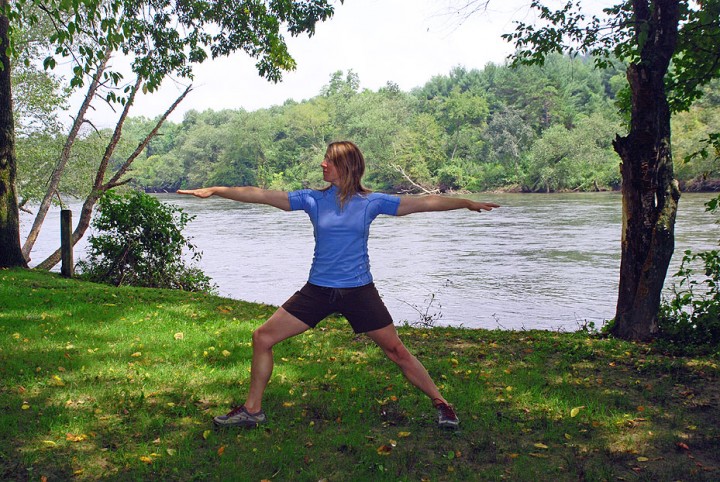
Lift you arms out to the sides as high as you can with no popping (a big task for a kayaker! Sometimes my shoulders are so tight that I can’t lift them at all without popping, so I just do the pose with my hands on my hips.)
Extended Side Angle Pose
From Warrior 2, place your hands on your hips. As you exhale, tilt your pelvis to the right and stretch to the right side. You will feel your right hip drop as your left one lifts. Stretch your right and left side waist evenly. Lift your left arm up—again, only in a range of motion with no popping.
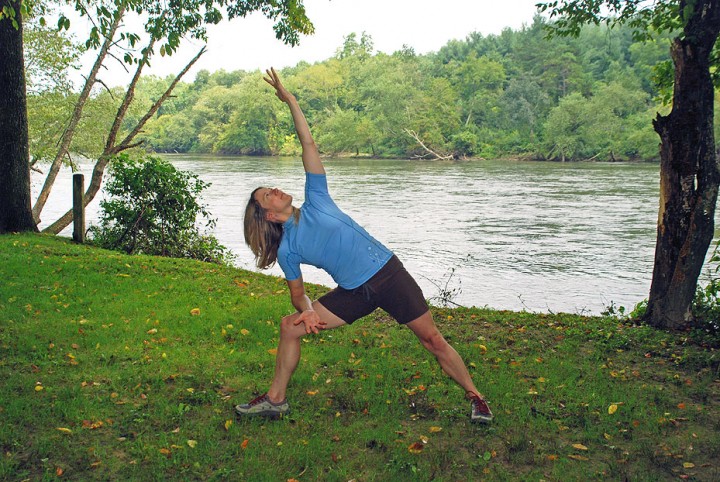
Half Moon Pose
From Extended Side Angle, bring your left leg closer to your right as you take your right hand to the ground a few inches in front of your right toes.
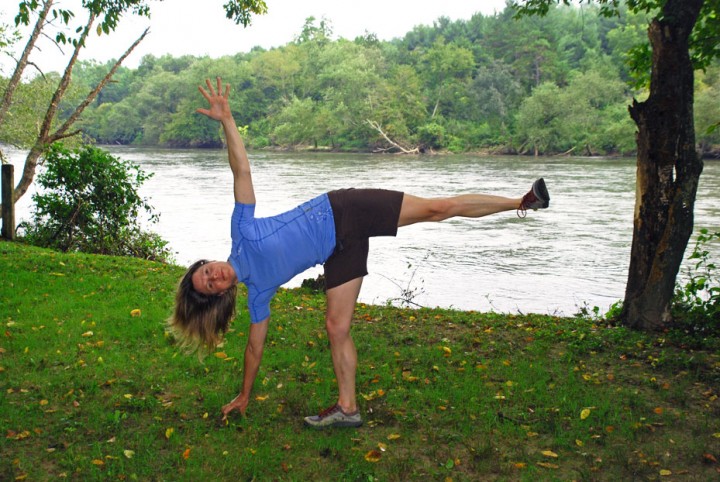
Shift all of your weight onto your right leg. Stack your hips over the right leg. Straighten your left leg—the knees and toes facing forward. Don’t put any weight on your balancing hand! Let your core and hips do the work. You can bend your standing leg knee as much as you need to—don’t strain! Reach your left arm up toward the sky if you want, or keep it on your hip.
Repeat this sequence to the other side and then come back to standing.
Warrior 3
From standing, extend your right leg behind you. As you exhale, begin to tip forward while bringing all of your weight onto your left leg. You can bend your left knee as much as you need. Keep your weight centered on your left foot or you can even bring it more into the heel. Lift your right leg behind you as much as you can without strain. Keep your buttocks level—if you need to, you can put your hand back there and see if your right hip is lifting up. If it is, slowly drop it back down to level with the left. Lift up with your core. If you want, you can reach your arms out like I am in the picture. However, it’s perfectly fine to keep them on your hips. This pose is a real killer for me—it challenges all the places that I get weak and tight from boating.
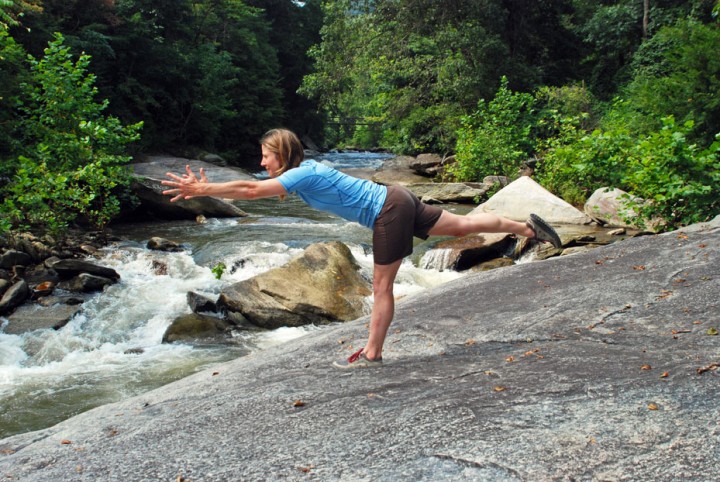
High Lunge
From Warrior 3, gently bring your right leg down behind you into a lunge. You can bend that back leg or straighten it. Over time, work on straightening it to get more stretch in those hip flexors. It’s a constant battle to keep those hip flexors supple!
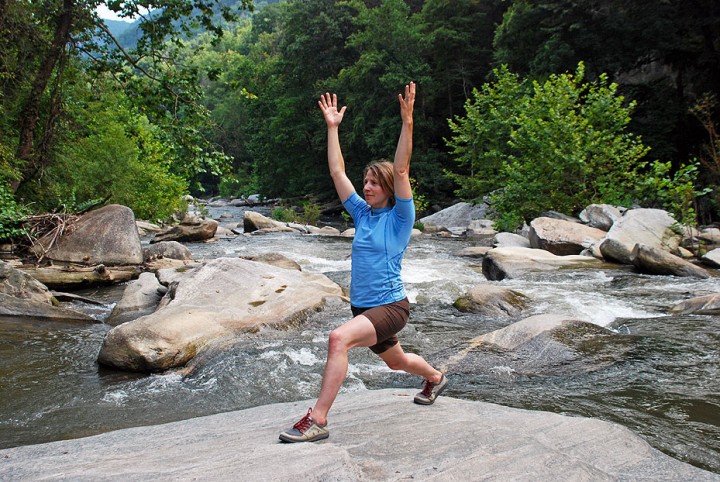
Make sure that your front knee doesn’t go forward past your heel and that it’s not falling inward or outward.
You can have your hands on your hips or lift them overhead.
Low Lunge
Carefully lower your back knee down to the floor. Keep your front knee aligned over your heel, and don’t let it fall inward or outward. Keep your hips in a neutral position—not tilting or twisting forward or backward. You can have your hand on your hips or reach them overhead for more stretch.

Locust Pose
This pose stretches the muscles of the front body and strengthens the muscles of the back body to help you bring balance back to your structure and hopefully ease back pain.
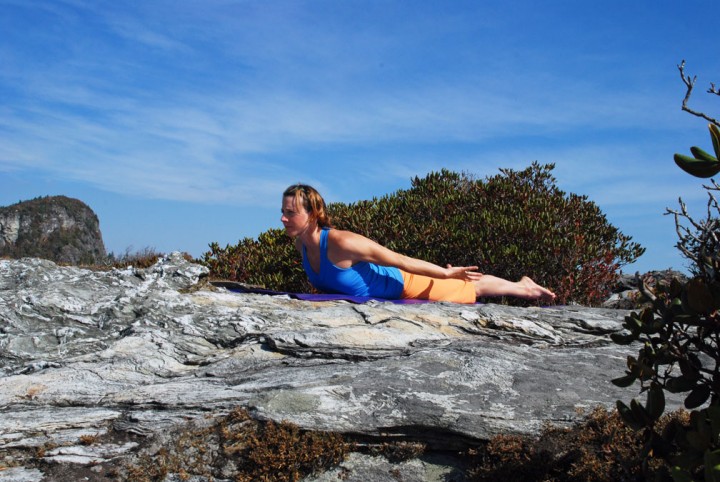
Lie in a prone position with your forehead on the floor, your feet about hip width apart and your arms by your sides with your palms facing up. Take a deep breath and release all tension. Inhale as you lift your legs, torso, and arms. Keep the head in line with your spine and take your gaze upward. Release tension from your face and jaws. Breathe fully. Exhale and slowly come down, then release completely into the floor.
Supine Twist
This exercise is fabulous for both strengthening and stretching your obliques and many other muscles of the torso and spine. It causes an “eccentric contraction” — an active stretch— which is exactly what your muscles are doing while paddling.
Lie supine with your arms out at your sides and your palms facing up so that your body makes a “T.” Bend your knees, and bring your legs up to a 90-degree angle from your body, being sure not to arch your back or rib cage. Exhale as you slowly lower your legs to one side. Only go as far as you can with no pain and without lifting your opposite shoulder off the floor. Do not rest the legs. Hang out for as long as possible and breathe. When you are ready, inhale to come up and exhale to the other side.
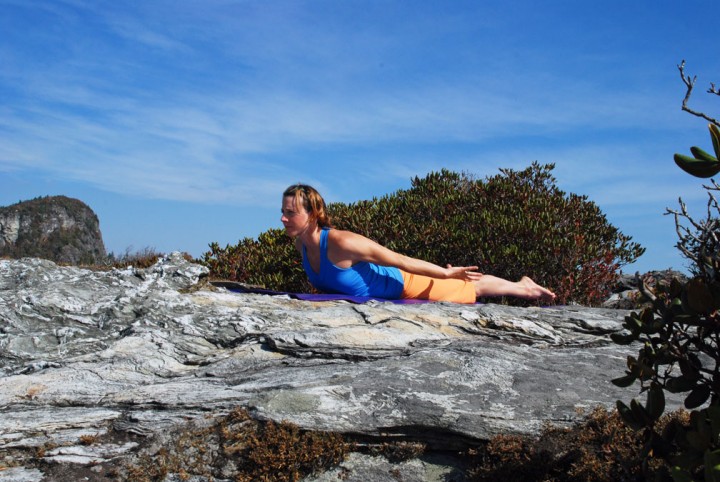
Next, try doing this last pose in a more relaxing way, by letting the bent legs relax on the floor.
 For paddlers living in areas with distinct boating seasons, cold or dry times of year can be a bummer. But, as author Andria Davis reminds us, the off-season gives you an opportunity to rejuvenate your body and mind. These yoga exercises are a great way to work on your paddling fitness when the water isn’t running.
For paddlers living in areas with distinct boating seasons, cold or dry times of year can be a bummer. But, as author Andria Davis reminds us, the off-season gives you an opportunity to rejuvenate your body and mind. These yoga exercises are a great way to work on your paddling fitness when the water isn’t running.
 NRS Gift Card: Always Fits, Always Wanted
NRS Gift Card: Always Fits, Always Wanted

